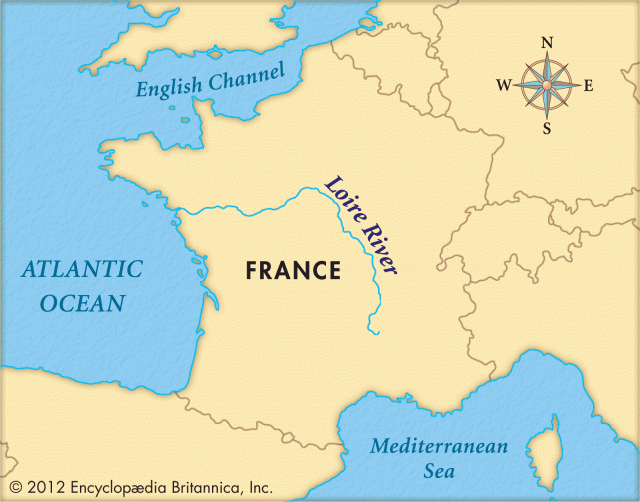Loire River
TO MANY PEOPLE, the Loire River defines FRANCE. It is the country's largest river and draws together its different regions, east and west, north and south. The Renaissance chateaus along its lower course are the second-largest tourist draw after Paris, and the river provides water and transportation for the nation's agricultural center.
From its origins in the remote peaks of the Cevennes in southeastern France to its wide estuary on the Bay of Biscay, the river crosses through, or forms the border of, 13 departments and crosses six historic regions, from Languedoc to Brittany. Seven cities with populations greater than 100,000 are included in its watershed (Orleans, Tours, Angers, and Nantes on the river directly, and Clermont-Ferrand, Limoges, and Le Mans on tributaries). The Loire flows for 627 mi (1,011 km), draining a watershed of 44,956 square mi (115,271 square km), one-fifth of France.

It is the last “wild river” of Europe, with no dams on its main course, and several of those that have been built on tributaries were recently destroyed under a government initiative, Plan Loire Grandeur Nature. This program has set aside funding for 2000 through 2006 to secure the river basin from floods, to regulate the production of nuclear and hydroelectric power, and to restore the region's natural habitat, notably its spawning grounds for Atlantic salmon, whose numbers have decreased over the last century from hundreds of thousands to mere hundreds.
Recognizing the importance of the lower valley's natural and historic beauty to the nation's economy, the government also heavily supports development funds for historic towns such as Blois, Chinon and Saumur and internationally famous castles such as Chambord and Chenonceaux. These efforts are reinforced by UNESCO (United Nations), which declared the Val de Loire a World Heritage Site in December 2000. Other projects are aimed to restore the environment of the Loire estuary between Nantes and its mouth at Saint-Nazaire, home to huge populations of freshwater and saltwater fish and migrating birds, which has been heavily polluted from harbor activities and large oil refineries on the north shore.
The Loire starts as a trickle from a small pipe on a volcanic peak (Gerbier-de-Jonc) in the Ardeche, 4,700 ft (1,425 m) above sea level, only a few meters from streams that find their way east into the RHONE, and to the Mediterranean. The swift mountain stream cuts deep gorges through the Massif Central, before passing the iron and coal centers of the 19th century at St.-Etienne (“the French Birmingham”) and Roanne. From Roanne, the river opens up onto the plains of the north. Because the river is fed largely from mountain snows, it is liable to swift and disastrous floods in the spring.
Below the town of Nevers, the Loire is joined by its chief tributary, the Allier, and becomes the wide and voluptuously slow river that is famous among painters and poets for its reflective surfaces and rose mists. The river arcs gradually westward, passing the wine region of Sancerre and the first of the grand Renaissance chateaus, Sully-sur-Loire. Other large tributaries enter the river in its lower courses, the Maine from the north and the Vienne, Cher and Indre from the south. From here to the sea, the Loire is the major transport highway for wine, vinegar, grain, salt, timber, stone, coal, and iron, though it has always been hampered by slow currents and a shallow riverbed with frequent and shifting sandbars.
Islands in the lower Loire valley disappear and reappear overnight, causing serious dangers to transport craft. Boats take grain—the region produces 50 percent of France's total—either downriver, or to canals connecting the Loire to the Saone-Rhone and Seine river valleys.
Although the river passes several large and historically potent cities—for example, Orleans, where Joan of Arc first defeated the English in 1429—the country-side is mostly rural, with numerous small villages. One in three “Ligerians” live in the countryside. The Loire Valley ends at Nantes, before opening up as the Loire estuary, with 35 mi (56 km) of rich wetlands. Nantes was traditionally France's gateway to the world's oceans (before being superseded by the deeper, more predictable waters of the Seine at Le Havre), and many French residents of North America trace their ancestry to emigrants from its ports.